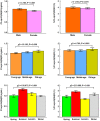C3-epi-25(OH)D3 percentage, not level, may be a potential biomarker to reflect its pathological increase in multiple diseases: a cross-sectional case-control study
- PMID: 38155294
- PMCID: PMC10754939
- DOI: 10.1038/s41598-023-50524-3
C3-epi-25(OH)D3 percentage, not level, may be a potential biomarker to reflect its pathological increase in multiple diseases: a cross-sectional case-control study
Abstract
National surveys in developed countries have examined the presence of C3-epimer of 25-hydroxyvitamin D3 [C3-epi-25(OH)D3]. However, controversy remains regarding its association with disease occurrence due to its high correlation with 25-hydroxyvitamin D3 [25(OH)D3]. This study aims to investigate whether %C3-epi-25(OH)D3 can serve as an indicator for this relationship with various diseases. A total of 3086 healthy participants and 4120 patients were included in this study. We investigated the association between C3-epi-25(OH)D3 and %C3-epi-25(OH)D3 levels with gender, age, and season; compared the performance of C3-epi-25(OH)D3 and %C3-epi-25(OH)D3 across different disease conditions; and explored the correlation between %C3-epi-25(OH)D3 and various diseases. Results indicated that C3-epi-25(OH)D3 varied significantly by gender, age, and season (z/χ2 = 3.765, 10.163, and 150.975, all P < 0.01), while only season for %C3-epi-25(OH)D3 (χ2 = 233.098, P < 0.001). In contrast to the significant decrease in C3-epi-25(OH)D3, %C3-epi-25(OH)D3 showed a significant increase in 8 out of 11 disease categories (z = 3.464 ~ 11.543, all Padj < 0.05). Similar opposite changes were also observed in most of the investigated 32 specific diseases. Moreover, an elevation in %C3-epi-25(OH)D3 was found to be significantly associated with 29 specific diseases both in univariate analysis (OR = 1.16 ~ 2.10, all P < 0.05) and after adjusting for gender, age, and season (OR = 1.15 ~ 1.50, all P < 0.05). However, after further adjustment for 25(OH)D3 levels, the association remained significant only for 15 specific diseases (OR = 1.11 ~ 1.50, all P < 0.05). Seasonal stratification analysis further supports the consistent association of %C3-epi-25(OH)D3 with disease across all or nearly all four seasons. In conclusion, %C3-epi-25(OH)D3 may better reflect the production of C3-epi-25(OH)D3 in disease conditions, thereby offering a more applicable approach to investigate its association with diseases. However, the interpretation of this relationship may be confounded by 25(OH)D3 as a potential covariate.
© 2023. The Author(s).
Conflict of interest statement
The authors declare no competing interests.
Figures



Similar articles
-
Differential performance regarding the relationship of C3-epi-25(OH)D3 levels and %C3-epi-25(OH)D3 with common pediatric diseases: a case control study.BMC Pediatr. 2024 Sep 13;24(1):577. doi: 10.1186/s12887-024-05072-8. BMC Pediatr. 2024. PMID: 39272033 Free PMC article.
-
C3-Epimer of 25-Hydroxyvitamin D3 as a Superior Marker for Predicting the Severity of Chronic Kidney Disease in Rheumatoid Arthritis Patients.Oxid Med Cell Longev. 2022 Apr 22;2022:5268706. doi: 10.1155/2022/5268706. eCollection 2022. Oxid Med Cell Longev. 2022. PMID: 35498132 Free PMC article.
-
National Estimates of Serum Total 25-Hydroxyvitamin D and Metabolite Concentrations Measured by Liquid Chromatography-Tandem Mass Spectrometry in the US Population during 2007-2010.J Nutr. 2016 May;146(5):1051-61. doi: 10.3945/jn.115.227728. Epub 2016 Apr 6. J Nutr. 2016. PMID: 27052537 Free PMC article.
-
Iatrogenic vitamin D toxicity in an infant--a case report and review of literature.J Steroid Biochem Mol Biol. 2015 Apr;148:14-8. doi: 10.1016/j.jsbmb.2015.01.022. Epub 2015 Jan 27. J Steroid Biochem Mol Biol. 2015. PMID: 25636720 Review.
-
Analytical measurement and clinical relevance of vitamin D(3) C3-epimer.Clin Biochem. 2013 Feb;46(3):190-6. doi: 10.1016/j.clinbiochem.2012.10.037. Epub 2012 Nov 12. Clin Biochem. 2013. PMID: 23153571 Review.
Cited by
-
Exploration of vitamin D hydroxy metabolites C3 epimers in patients with cardiovascular disease: an observational study.Biosci Rep. 2025 Jan 27;45(2):BSR20241558. doi: 10.1042/BSR20241558. Biosci Rep. 2025. PMID: 39873593 Free PMC article.
-
High ratio of epi-25-(OH)-vitamin D3 to 25-(OH)-vitamin D3 increases the risk of asthma attack in American asthma adults: a population study.BMC Public Health. 2024 Sep 30;24(1):2670. doi: 10.1186/s12889-024-20185-6. BMC Public Health. 2024. PMID: 39350112 Free PMC article.
References
-
- Bizzaro G, Antico A, Fortunato A, et al. Vitamin D and autoimmune diseases: is vitamin D receptor (VDR) polymorphism the culprit? Isr. Med. Assoc. J. 2017;19(7):438–443. - PubMed
MeSH terms
Substances
Grants and funding
LinkOut - more resources
Full Text Sources
Medical
Miscellaneous

